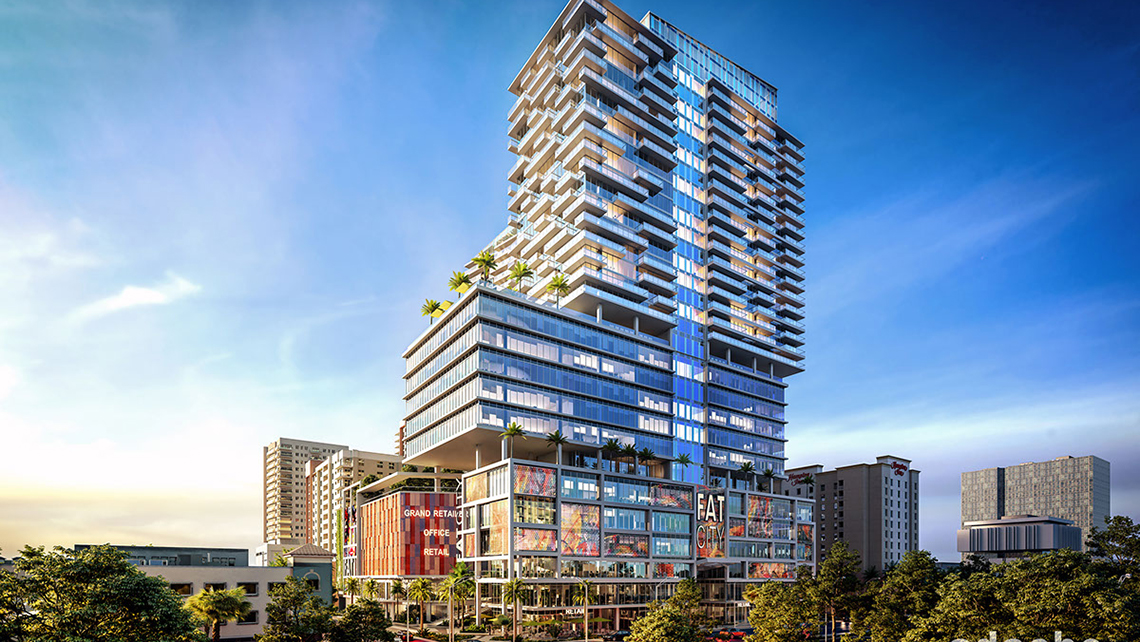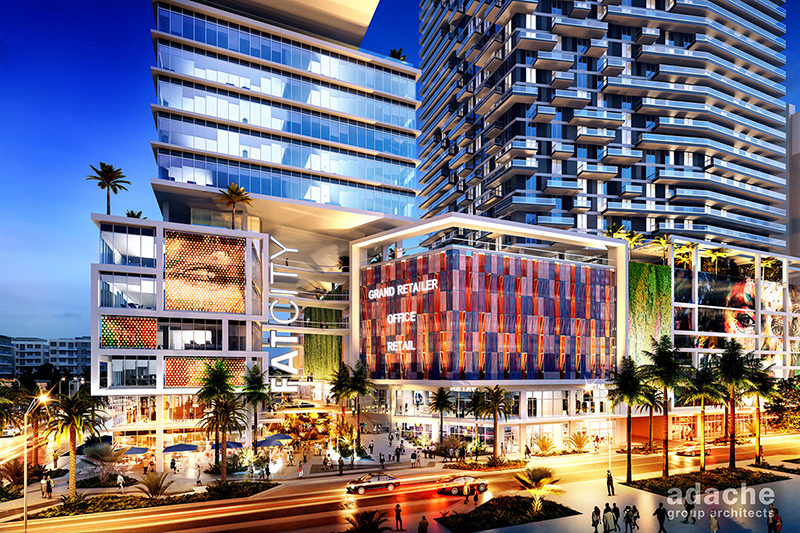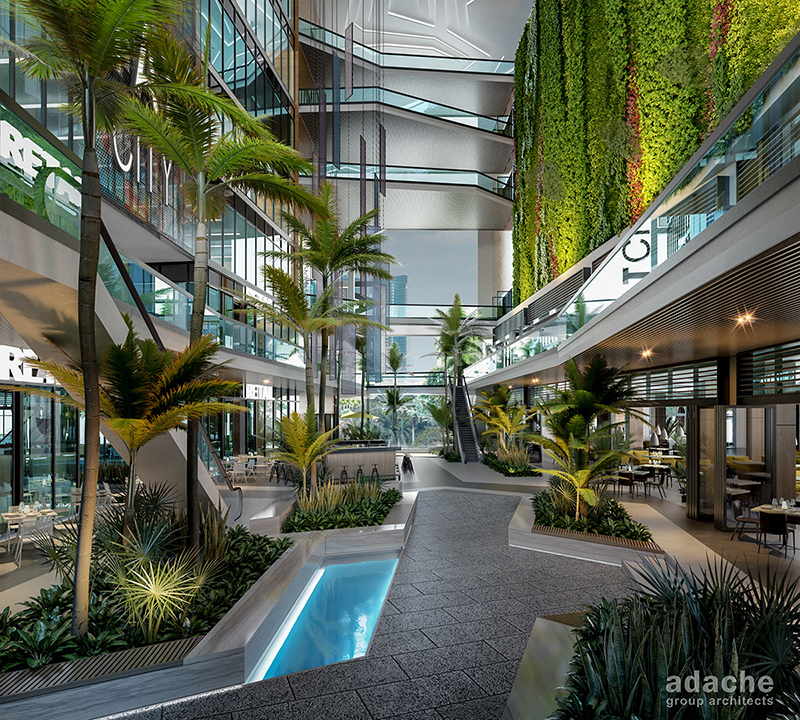
FAT City may be too much for Fort Lauderdale to digest.
The city-approved real estate development on North Andrews Avenue takes its name from nearby FAT Village (Flagler Arts Technology), the artsy collection of galleries, studios and food-and-drink spots just north of downtown. It would be a vertical small town, a 1.35 million-square-foot combination of offices, apartments and stores at 300 N. Andrews Ave., two blocks north of low-rise City Hall, where the previous City Commission approved FAT City in July 2017. As designed and approved, FAT City has two 30-story buildings that would tower over FAT Village and its larger residential counterpart, the rapidly building Flagler Village area north of downtown.
However a challenging environment for downtown office development may be one of the reasons why FAT City still wasn’t under construction by the summer, one year after the city approved it. Any groundbreaking ceremony is on hold as the developer tries to cash in at least part of its equity stake in the project. The developer, Traina Companies, announced in May that it wants to sell all or part of the 2.69-acre development site, which comes with the city’s green light for the FAT City project.
New York-based Traina acquired the development site in 2013 and 2016 purchases that totaled about $8.4 million, according to The Real Deal, a real estate news website. Why Traina wants to sell all or part of the project isn’t clear. Traina declined a request for an interview. So did South Florida agents of brokerage Avison Young who are marketing the FAT City development on behalf of Traina, without an asking price.
Others question aspects of the development.
“Flagler Village has really become the place where you build eight- to 12-story buildings, not necessarily where you build 30 stories like you would along Las Olas,” says Peter Mekras, managing director of Aztec Group. Nevertheless, he says, downtown “has very good demand for office space and very good demand for rental apartments.”
There is ample supply to meet that demand, too. Hundreds of apartments are under construction in the FAT Village/Flagler Village area, where live-work-play developments that combine rental housing and commercial components have clustered.
Apartment construction remained widespread in the FAT Village/Flagler Village area as 2018 began. The area “is quickly becoming one of the region’s largest concentrations of mixed-use development. As of February 2018, there are nearly 1,000 multifamily [apartment] units and 60,000 square feet of office space currently under construction,” according to a research report by commercial real estate brokerage Avison Young.
It is debatable whether the cluster of apartment developments there is turning into a crowd. In any case, the company behind FAT City hedged its bet on rental housing last year by trimming its planned number of apartments to 612 from 626. The cut came after the city government’s Design Review Committee looked at plans for FAT City in March 2017 and suggested architectural alterations to make the two-tower development look less bulky.
Ample office space distinguishes FAT City from many other mixed-use real estate developments with a residential component. Indeed, FAT City would be one of the biggest new office developments
to open in the downtown area in years. It is approved for 183,011 square feet of office space, plus 88,192 of retail space.
But at nearby sites, two competing office buildings already are in the construction-and-preleasing stage of development.
Fort Lauderdale-based Stiles Corp. has spent much of the summer preparing a site at 201 E. Las Olas Blvd. for construction of a 25-story office building. Named after its address, 201 East Las Olas will have 356,948 square feet of office space and 17,450 square feet of retail space, just one-fifth of the amount that FAT City would have.
Among other features, 201 East Las Olas will have “12-foot, floor-to-ceiling windows,” says Adrienne Zalkind, vice president of marketing at Stiles. “There really isn’t anything like it in the market.” Stiles expects to open its office building in November 2020.
Just south of downtown across the river, a smaller office building is under construction at 550 S. Andrews Ave., near a Publix supermarket.
The developer, Blackhawk Properties & Investments, got a $32.5 million loan in the spring to finance construction of the seven-story building, which will have 95,500 square feet of office space, 13,000 square feet of ground floor retail space, and an eight-story, 660-space parking garage. Blackhawk is a group of locals led by South Florida real estate investors Kate Murphy and her father William Murphy, together with Thomas M. McDonald, president of Craven Thompson & Associates Inc., a civil engineering firm in Fort Lauderdale.
Construction of The 550 Building is under way, and tenants were expected to start moving in by April 2019. Attorneys had taken the bulk of the preleased space at The 550 Building by the end of June. “That’s who we’re seeing a lot of, especially as the building gets further and further along,” says Joseph Byrnes, senior vice president, Berger Commercial Realty, who is leasing the building on behalf of the developer. “We’ve got a floor and a half of the office space spoken for there.”
Asked about competition for tenants from rival office developments, Byrnes says the company behind FAT City is “competing with Stiles more so than we are, thankfully.”
The Berger Commercial Realty executive says Stiles is offering attractive deals to existing office tenants in Fort Lauderdale to entice them to prelease space at 201 East Las Olas. “Stiles has been making some pretty aggressive overtures to them,” he says. “That’s causing some concern among some of the owners who have paid a lot of money in recent years for the higher-rent [office] buildings” in downtown Fort Lauderdale.
Downtown office owners also face plenty of suburban competition. “There has been some flight back up to Cypress Creek,” Byrnes says. “Certainly Plantation is a strong market.” Some downtown property owners also were disappointed by the cancellation of Fort Lauderdale’s long-planned streetcar system, the Wave, which would have looped around the central business district. “It’s unfortunate,” Mekras says. “It was a good selling point for leasing agents with apartments and brokers selling property.”













